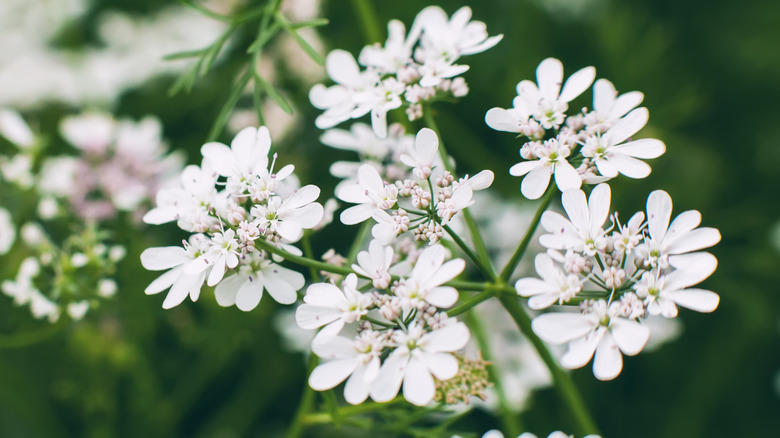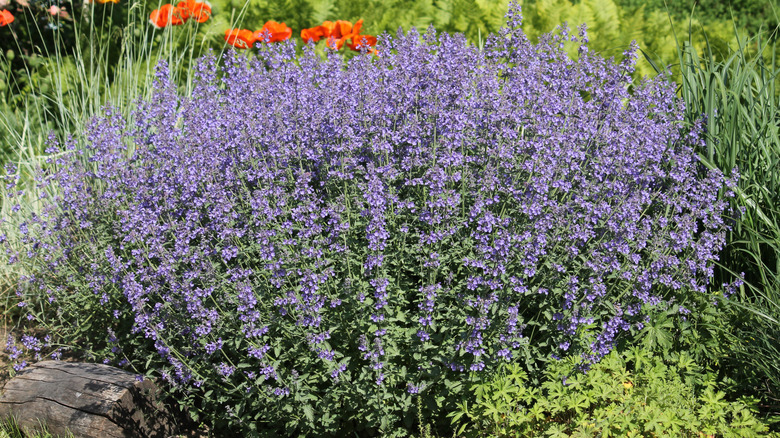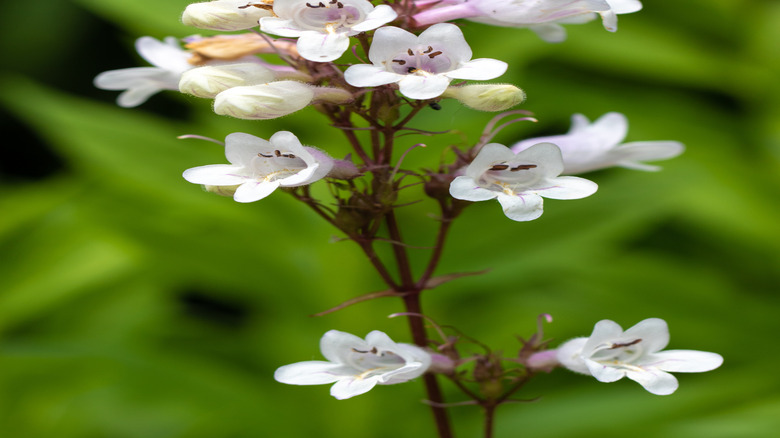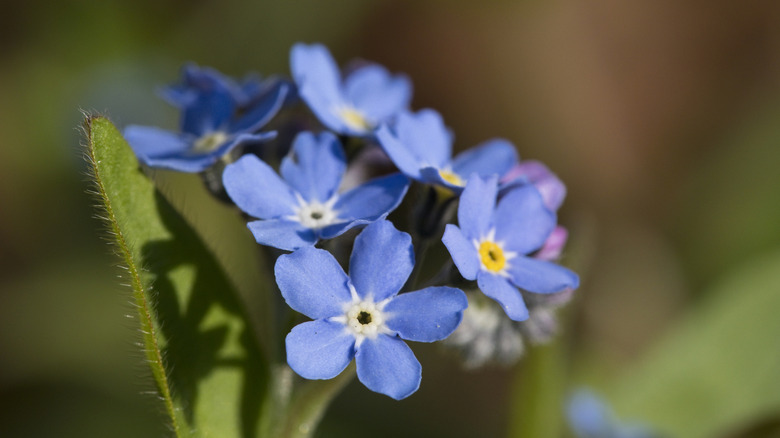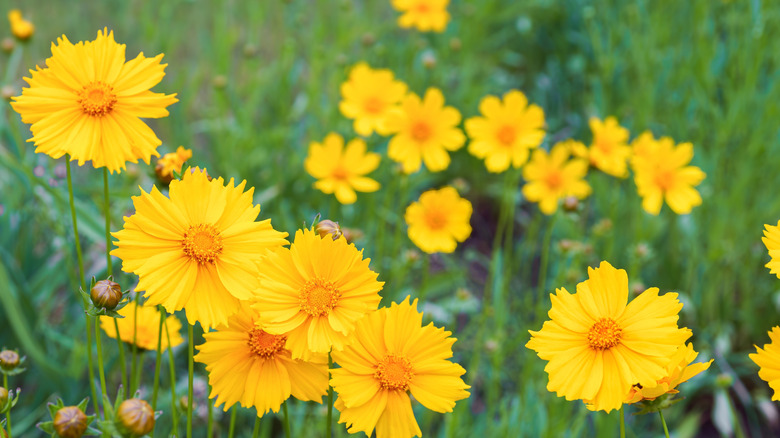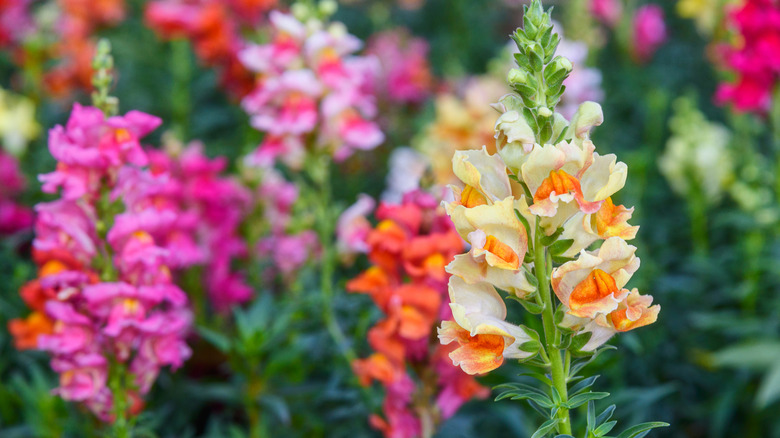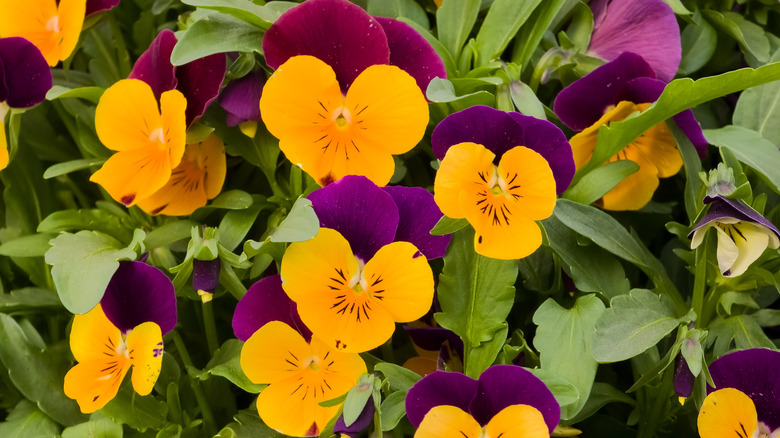21 Garden Seeds To Sow In November For A Colorful, Budget-Friendly Garden In Spring
If fall and winter holiday preparations are stretching your November budget but you don't want to forget about your garden, growing plants from seed could be the low-cost option you need. Luckily, November is a perfect time to sow seeds of colorful plants ranging from perennial flowers to green herbs. For the amount you'd spend on a single container plant, you can get a bigger variety from more affordable seed packets. Seeds can even be completely free if you tap into the practice of harvesting seeds from plants that are already growing in your garden, swapping them with other gardeners, or even finding a seed library. Put those seeds into the ground in November, for plants in a rainbow of colors come spring, such as poppies, sweet peas, and woodland forget-me-nots. Herbs like dill and parsley can also be started from seed in November as long as your climate supports it.
Many seeds do well when sown in November. Native wildflowers often need to undergo cold winter temperatures to germinate properly, and November often comes with rain and leads into a long stretch of cold days. In warmer climates where frozen ground isn't a worry, November is perfect for growing herbs and certain flowering plants that will bring beauty to your garden landscape by spring.
There are some practices to follow so your seeds have the best chance of yielding successful plants. Store the seeds in a cool and dry place, like your refrigerator's crisper, and make sure to use them within a year of when you obtain them. The percentage of seeds that will germinate may lessen over time, so don't delay sowing if the time is right.
Larkspur
For tall spikes adorned with blue, pink, or white blooms in the spring, sow some larkspur (Consolida ajacis). This annual flowering plant needs cold temperatures for its seeds to take root, and then rewards gardeners with showy blooms from the late spring into the summer. As long as your climate is temperate enough, sow them in November before frost season and the cold period to come will help the seed along. Leave 4 inches between the seeds when planting them, and cover them with a light dusting of soil about ⅛ inches thick.
Common coreopsis
When you sow common coreopsis seeds (Coreopsis grandiflora) , you can look forward to vibrant yellow blooms in late spring. This wildflower, also known as large flower tickseed, thrives in zones 4 through 9, especially in sunny garden spots with well-draining soil. Its showy flowers are bigger than threadleaf coreopsis, which you can plant in November for cheery summer blooms. Sowing coreopsis seeds in November is ideal in climates when late fall leads into a cold winter, since these temperatures will naturally help them break out of their dormant stage in a process called stratification.
California poppy
The bright orange California poppy (Eschscholzia californica) is a herald of springtime in the southwestern United States, but you can actually sow their seeds in the fall, even as late as November, in zones 8 through 10. You'll typically see the poppies bloom in early spring and into summer throughout these warm-weather areas. Shallow planting lets the seeds get the benefit of autumn rain, which helps with germination. After they bloom, you can harvest seeds from the capsules left on the plant, or let it reseed itself in the garden.
Cilantro
If you live somewhere with mild winters, November is a great time to establish your herb garden by getting cilantro (Coriandrum sativum) started from seed. Cilantro is a cool weather-loving plant, and when sown in late fall it can have a prolific bloom in early spring before facing the hot conditions that make the plant go to seed. Try sowing in November in zones 8 through 10 to take advantage of the ideal growing weather. As an added little gift, the cilantro may self-seed, which can reduce the effort you need to keep it going until the next spring.
Sundial lupine
Look forward to charming spikes of purple, blue, or pink flowers in the spring when you sow the seeds of sundial lupine (Lupinus perennis) in November. Its germination depends on being exposed to cold weather, so it's a smart move to sow the seeds just before winter. Planting them in late fall instead of early spring saves you from having to try seed scarification, a process gardeners use to break down seed coatings when it can't be done naturally. This perennial is native throughout the eastern U.S. and thrives outdoors in zones 3 through 8.
Catmint
A favorite of both cats and flower admirers, catmint (Nepeta spp.) isn't fussy about its preferred soil type and can provide you with multiple flushes of small purple flowers over the warm season. In zones 3 through 8, you can plant this perennial in November for a luscious spring garden. The moist, cold climate of November and the months beyond will give its seeds the cues they need to bloom around May. Once they're done blooming, you can cut off withered flowers and trigger a second bloom that could even last until fall, when the cycle begins again.
Sweet pea
The sweet pea (Lathyrus odoratus) is an annual that flourishes best in cool weather. It blooms in a variety of colors, ranging from pink to red and yellow, in spring through summer, and if you're in an area with mild winter weather within zones 8 through 10, November is a great time to sow its seeds. A late fall planting allows their roots ample time to grow before they bloom. They love nutritious soil, so add some compost before you plant their seeds in furrows of 1 inch. Leave 2 to 3 inches between each seed planting.
Dill
By planting dill (Anethum graveolens), you get flavorful, fragrant herbs to use in the kitchen as well as lacy leaves or even attractive yellow flowers if you're growing it ornamentally. Dill loves cool weather, but since you still need to avoid frost, only plant it outdoors in November if you're in a warm area such as southern California. Sow the seeds ¼ inch in loosened garden soil, without burying them so they can germinate by sunlight. Also, make sure you choose a good location and stick to it, since dill's taproot doesn't like being disturbed for replanting.
'Husker Red' beardtongue
Tall, pollinator-attracting beardtongue (Penstemon) plants are great for flowering border gardens and the thawing and freezing cycle that starts in November wakes up their seeds, but you'll need to look for a specific cultivar if you want to see blooms the same year they're sown. That's where penstemon digitalis 'Husker Red,' also known as foxglove beardstongue, comes in. These perennials with reddish leaves bloom in the middle of spring, producing white, sometimes pink-tinged, flowers. Plant the seeds in sunny spaces where the soil drains well, since they're prone to root rot if winter precipitation pools around them.
Common blue violet
Add the easy-to-grow common blue violet (Viola sororia) to your November sowing list, since they're cool-season plants that use the winter months to grow strong roots. Their small purplish or blue blooms peek out in the beginning of spring in zones 3 through 7, after which the plant spends the summer nourishing pollinators. Scatter the violet seeds in compost-rich garden soil with a quarter inch of soil on top, and water them well. It can be helpful to add a layer of mulch around the plants to protect their roots as they grow over the cold months.
Woodland forget-me-not
Woodland forget-me-nots (Myosotis sylvatica) pop up with sweet blue flowers you'll remember long after their season ends. They can overwinter successfully, so if your climate is mild enough you can plant them in November for spring flowering. Sprinkle them onto moist soil that has been raked over and toss on a light soil covering. If your climate isn't so mild, you can still try planting the forget-me-nots in November, but add some insulating mulch. Woodland forget-me-nots are considered noxious weeds in parts of the Midwest, and they can take over a patch quickly, so garden with care!
'Snow Lady' Shasta daisy
November in a mild climate isn't too late to sow Shasta daisy (Leucanthemum x superbum) seeds, but they don't all bloom in the first spring. 'Snow Lady' Shasta daisies are bred to give you a satisfying bloom starting in May, throughout zones 4 through 9. Don't bury the seeds too deeply because the sun can aid in their germination. A 'Snow Lady' daisy will be shorter in height, so you don't have to worry about staking its stems. Make sure it's safe from winter dangers like over-saturated soil, and this daisy should delight you with a long blooming season.
Garden poppy
The garden poppy (Papaver somniferum) has the dramatic bright petals and visible seeds that represent what many people think of when hearing the word "poppy." The blooms can be vivid red, or other hues like orange or purple. You can sow poppy seeds in November in certain regions across zones 2 through 7; the cold winter helps them grow and they have some frost tolerance. Sow them shallowly and place just ⅛ inch of soil on top, since they need light to help with the germination process. It's also a good idea to keep the ground moist after sowing the seeds.
Lanceleaf coreopsis
Just when you think your planting window has passed, wildflowers like lanceleaf coreopsis (Coreopsis lanceolata) come to the rescue. With yellow flowers and spear-like leaves, this type of coreopsis is best planted when soil temperatures fall under 50 degrees Fahrenheit and it needs cold stratification, so November is a perfect time to sow. Plant the seeds no more than a quarter of an inch deep in zones 4 through 9. Be aware that the flowering may be slow to start the first year, but the resilient plants can tolerate some freezing and establish themselves in a few years.
'Camelot' foxglove
If you love the funnel-shaped and dotted flowers of foxglove (Digitalis purpurea) but want blooms in the first spring after sowing their seeds in November, try the 'Camelot' cultivar. This plant develops hardy roots over the winter in mild climates, and in the spring it blooms in colors like rose, lavender, cream, and white, which sometimes come together in mixed packets. Its biennial relative common foxglove takes a whole year longer to bloom. Give 'Camelot' a scant covering of soil and plenty of water, and eventually thin the patch to ensure enough space between the plants.
Nigella
Nigella (Nigella damascena) is also known as love-in-a-mist because of the wispy leaves that surround its blue, purple, pink, or white flowers on stems that can reach 2 feet tall. The plant does well starting out in chilly weather, like November, in a region where winters are mild. Sow Nigella seeds directly in the ground and cover them with ⅛ inch of soil in areas that get full sun. Its blooms appear in springtime, and even though they last for just a few weeks, the plant structure adds an interesting look to an annual flower bed.
Calendula
The calendula (Calendula officinalis), nicknamed "pot marigold," is a cold-hardy flowering herb that will bring pops of yellow and orange to the spring and summer garden after it's sown in November. This edible plant has long served as both an ornamental and in herbal remedies. They're known to survive the winter when sown in autumn where the climate is mild. In warm regions, sow calendula seeds below ½ inch of soil so the darkness can help them germinate. Don't be alarmed if your calendula takes a break from blooming in soaring summer temperatures; they rebound when it gets chilly again.
Snapdragon
Snapdragon's (Antirrhinum majus) preference for low evening temperatures makes November a good time to sow them where winter weather tends to be mild, such as in zones 7 through 11. These cool-loving plants spend fall germinating and winter growing into the plants that will flower in hues of yellow, pink, purple and more around May. They also go dormant over the colder months and have a reduced need for water. Despite snapdragons' ability to survive the winters and endure some degree of frost, it's still a good idea to blanket them with some pine needles in severe cold snaps.
Woodland sage
Filling in garden spaces with woodland sage (Salvia nemorosa) adds to the whimsy of the landscape. There are cultivars of this violet-flowering plant, such as 'Spring King,' that bloom early in the season, getting a head start on feeding pollinators and delighting gardeners. Their hardiness makes November seeding possible for woodland sage in climates without heavy frost, and they're happy in well-draining soil and full sun areas. After their spring bloom, there's a trick to saving yourself money and extra work: Leave some of the seed heads intact to encourage them to self-sow in your garden.
Pansy
The multicolored bloom of a pansy (Viola x wittrockiana) often marks the beginning of spring. These flowering plants aren't comfortable in intense heat and instead prefer temperatures colder than 65 degrees Fahrenheit, making it possible to plant them in a garden bed during November. Make sure they're well-mulched and wait for their early spring flowers to unfurl. In the springtime, snipping off dead flowers will help stretch their blooming season further. It's worth planting many seeds, letting a wide variety of color combinations liven up the garden. Pansies thrive best over the winter in zones 8 through 11.
Eastern red columbine
The May and June bell-shaped blooms of Eastern red columbine (Aquilegia canadensis) are known to attract hummingbirds. Sowing the seeds of this native plant in November (but not too deeply beneath the surface) will expose the seeds to the cold stratification they need. After a one-month spring bloom in zones 3 through 8, the plant can seed itself in your garden and the leaves can serve as a ground cover. It's important to make sure the soil you plant Eastern red columbine in drains well, but it thrives in a variety of conditions.




